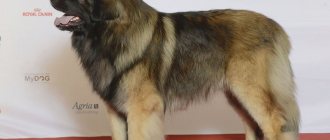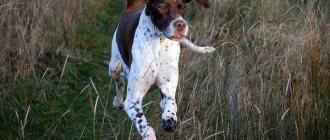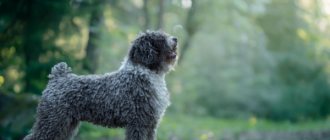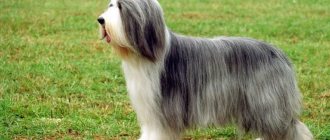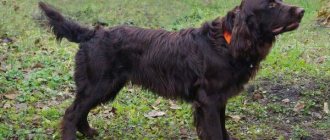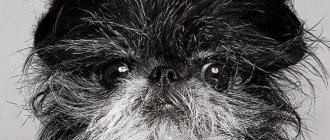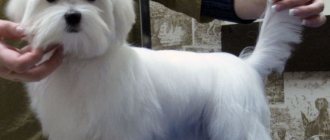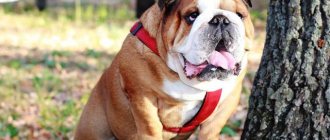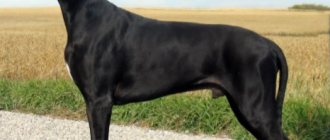Breed characteristics
| Short description | |
| Origin: | USSR |
| Conditions of detention: | In an enclosure in the courtyard of a private house; under certain conditions - in an apartment |
| Purpose: | Service, security guard, sentry |
| Color: | Black-backed (solid) black, against a background of light fawn or gray to black shade of the main color, zoned with gray markings. Red shades are possible. |
| Wool length: | Average |
| Adult dog sizes: | Male: height (withers) – 66-76 cm, weight – 35-60 kg/ Bitches: height (withers) – 62-72 cm, weight – 30-50 kg |
| Average life expectancy: | 12-14 years old |
| Walk: | Required twice a day, minimum duration of at least an hour |
| Physical activity needs: | High need for exercise, requiring significant daily activity of more than 3 hours a day |
| Fédération Cynologique Internationale (FIC) classification: | The breed is not recognized |
| Puppy price: | From 20 to 75 thousand rubles. |
History of the origin of the species
The ancestors of the East European Shepherd are considered to be German shepherds, which were brought to the territory of Tsarist Russia at the beginning of the 20th century - in 1904 . Initially they were used in the field conditions of the Russo-Japanese War. Dogs of this breed have proven themselves to be excellent in finding the wounded and notifying paramedics of their location. A little later, German shepherds replaced Dobermans in police service.
After the end of the First World War, German Shepherds began to be actively used for guard duty at military and border facilities, as well as for guarding prisoners in camps. German Shepherds perfectly met all the requirements of powerful and strong escorts.
The primary task of the young Soviet government was to ensure order, and therefore most of the service dogs that were imported into Russia from Germany were not intended to be used for breeding. Mostly “workhorses” were purchased, which had excellent security characteristics. However, the use of these dogs in the harsh conditions of the North, where the bulk of the settlement colonies were located, led to a sharp reduction in their number due to their low resistance to cold climates.
On the other hand, there was also no possibility of constantly replenishing the number of dogs, since they were purchased for foreign currency, the resources of which were limited.
Naturally, there is a need to select our own breed, which is not inferior in performance characteristics to the German Shepherd . It had to be a balanced dog, resistant to the climatic conditions of the country, with high security properties. Considering that German shepherds had all the necessary qualities, this particular breed was taken as the basis for selection.
The date of organized selection can be considered 1924, when the Red Star nursery was created, in which the first attempts were made to breed a new, universal breed. The West German line was used as a basis, but the lack of experience and proper funding did not lead to a positive result. By the beginning of the Second World War, no particular success in breeding had been achieved. In addition, most of the dogs died during the hostilities.
In the post-war period, the situation began to improve, largely due to the fact that magnificent “pure” examples of the breed ended up in the USSR along with German prisoners of war. Their breeding characteristics became the basis of the species now called the East European Shepherd (abbreviated as VEO).
Initially, selection was carried out by private individuals. However, very quickly, law enforcement kennels are included in the process, supplying dogs for breeding. Later, the newly created professional dog breeding clubs are involved. The purpose of founding the latter was the need to register and record puppies, to identify representatives of the breed most suitable for breeding. Finally, exhibitions begin to be held, based on the results of which adjustments are made to selection plans.
All events lead to the approval of the first BEO standard in 1964. Since its “official recognition,” the breed has been rapidly spreading and is a success not only among government officials. Ordinary people are beginning to pay more and more attention to massive and hardy dogs, which, unlike the German Shepherd, look more reserved.
In the 70s of the 20th century, Eastern European culture received well-deserved wide recognition.
How do the breeds differ?
The differences between the “German” and the VEO are enough to speak of them as different breeds. VEO has not yet received official recognition from the FCI. On the territory of the former republics of the USSR, the RKF standard is recognized, describing its features. East European Shepherds can only be exhibited in Russia, Ukraine, Belarus, and Kazakhstan.
Difference in external data
How the German Shepherd differs from the Eastern European is that it is less massive:
- East European Shepherds are 7 cm taller than their German relatives (average height 67 cm and 60 cm, respectively);
- VEO is almost 20 kg heavier;
- the chest and paws of VEO are much wider and more powerful.
In VEO, the line of the back runs almost horizontally, while in Germans it is slightly inclined towards the sacrum (about 23⁰).
Both shepherd dogs move at a trot; the “German” has a smoother gait due to the greater flexibility of the body. Maximum running speed:
- for the “Germans” - up to 48 km/h;
- for “Eastern Europeans” - up to 40 km/h.
Video: advantages and disadvantages of the “German”
The difference between the German Shepherd and the Eastern European is in the temperament of these two breeds:
- East European Shepherds are more balanced, phlegmatic, and can better tolerate the absence of their owner, although they are very bored. These pets are wary of strangers, but they do not show causeless aggression and treat other animals calmly.
- “Germans” are choleric, they require constant attention and active movement. A long absence from their owner makes them anxious and can result in loud barking, howling or damage to furniture. During walks, they need to be constantly monitored, since the sight of other animals awakens their hunting instinct.
Distinctive features
The East European Shepherd is included in group 1 of the RKF classification . One of the main features of the East European Shepherd is its size, since the trophy German dogs that were used to breed this breed were originally taller representatives.
Main characteristics of the exterior:
- The head is large, proportional, wedge-shaped. The frontal part is round, wide, the transition to the muzzle is smooth.
- The ears are medium-sized, pointed, triangular, directed slightly upward and forward, erect, set high and wide, with little hair. They stand up by about a year.
- The bridge of the nose is smooth, sometimes a hump is possible (not a defect).
- The muzzle is long, with a faint furrow.
- The nose is rectangular.
- The nose is black.
- The nostrils are large, open, and black.
- The eyes are medium-sized, oval, set slantwise, color – shades of dark brown, amber.
- The eyelids are dense, dry, and completely hide the whites of the eyes.
- The lips are dark, moderately thick, dry, and fit tightly to the muzzle.
- The teeth are white and strong. The standard implies 42 teeth, including incisors and canines.
- bite .
- The cheekbones are rounded.
- The jaws are well developed.
- The coat is of medium length, close to the body, the hair is hard; The undercoat is thick and light in color.
- The withers are pronounced.
- The neck is oval.
- The body is powerful, strong, heavy. The muscles are clearly defined.
- The limbs are strong, sinewy, smooth, the joints are strictly parallel to the body, the paw pads are black.
- Color: Black (solid) black, against a background of light fawn or gray to black shade of the main color. Possible red shades, the presence of white spots in the chest area (undesirable signs).
- The tail is saber-shaped and carried low in its natural position.
Photo of an adult dog
Photos of puppies
Features of character and behavior
The East European Shepherd is an example of a fearless, reliable, confident dog, controlling any situation from beginning to end, movements are smooth and free. Type – strong, balanced, agile.
- Very loyal to their owner, these dogs can show aggression in unfamiliar situations if, in their assessment, the owner is in danger. The owner must take into account this feature of the breed and control his emotional state.
- Dogs are excellent at “reading” human signals, and at the slightest suspicion of a threat, they can display a protective reaction. Considering that a strong relationship is created with the owner, the decision to adopt an East European Shepherd must be approached very carefully. If it is not possible to establish contact, it will be difficult to give the animal to other conditions without damaging its psyche.
A dog often chooses one owner for life and, subject to proper training, treats other family members neutrally.
- She is tolerant with other dogs and animals after OKD.
- Among other character traits, an outstanding mind and a high ability to learn and master discipline stand out. Dogs know how to work hard, and their performance in training is at a high level.
Advantages
Among the main advantages of the East European Shepherd, it is necessary to separately mention the following:
- These dogs have first-class watchdog qualities and are an ideal option for guarding a private home.
- They are very observant, have amazing instincts, and are able to instantly navigate a situation.
- Always ready to act to protect the owner.
- Balanced, not prone to escape.
- A high level of trainability, inherited from German shepherds.
Flaws
Despite its excellent characteristics, the East European Shepherd, like any service dog, requires special treatment.
- They may be wary of new family members. However, with regular increased loads and training, they become excellent friends.
- The dog is psychologically stable, but given its developed watchdog qualities, it is considered that it is not suitable for novice dog breeders who have no experience interacting with large service breed dogs.
- Also, the East European Shepherd is not suitable for people with a soft character . In these cases, it will pose a serious problem both for the owner and his family members, and for others.
- Given the large size of the dog, it will be difficult to cope with it. During a walk, he may not obey commands and show aggression towards other dogs and animals. Training in this case will only partially solve the problem, since the dog will obey the trainer, while in his absence, cultivate an aggressive style of behavior.
- Many trainers prefer not to work with these dogs precisely because of their incredible tenacity. However, the East European Shepherd cannot be called wayward. After all, the ability to clearly and quickly perform a security task are those traits that were specially bred through selection.
As one of the shortcomings, cases of unfriendly attitude towards children aged from 3 to 5 years were noted. However, with a competent and timely training course, problems do not arise.
Character
A properly raised Eastern European dog will be friendly towards all members of its family. They obey their owners well and are quite loyal to them.
But the breed is characterized by being wary and unfriendly towards strangers. They will try to protect the house and owners. This is due to the fact that the breed was originally bred as a service dog.
Although East European Shepherds treat the whole family well, they always have one leader – the leader.
They are devoted to him and love him selflessly. These dogs get along quite well with other pets. They are calm about their presence in the house, especially if they have known them from early childhood.
A distinctive feature of the breed’s character is its analysis of what is happening. They are distinguished by intelligence and rarely rely only on instincts.
They are indeed willing to attack anyone who poses a danger to their owners or home, but they will not prey on other pets or children.
Dogs get along quite well with children, but you should still not leave a small child alone with a dog. Adult supervision will be required in this case.
Otherwise, the baby may get hurt while playing. After all, an animal cannot always correctly calculate its strength, and the East European Shepherd has plenty of it.
Care and maintenance
The East European Shepherd is an unpretentious breed that does not require special care. Preferred conditions of detention are an enclosure built in the courtyard of a private house. However, with the correct load, it is possible to keep it in an apartment.
In addition, there are recommendations that are common to all dogs - weekly checking of the ears and eyes (it is recommended to do it daily during tick activity). It is also necessary to trim the nails, and the dog must be accustomed to this process from the age of two months - many do not really like the procedure and often resist it.
If a dog eats natural foods, vitamins must be present in its diet. Most often, special additives are used for teeth and bones.
Nutrition
The nutrition of a VEO puppy is based on the following scheme:
- Puppies aged 2-3 months : 5 feedings, the volume of each feeding is 200 g, by 3 months the volume is gradually increased to 300 g;
- Puppies aged 4-6 months: 4 feedings, the volume of each feeding is from 300 g. at 4 months up to 400 gr. by 6 months;
- Puppies aged 7-12 months : 3 feedings, the volume of each feeding is up to 700 g.
After 12 months, puppies are considered adult dogs and are transferred to two meals a day, standard for large breeds, while the amount of food is reduced.
To calculate the daily intake of an adult dog, it is necessary to multiply its weight by 2-3%, depending on the level of expected physical activity. For example, for an average male weighing 50 kg. and high physical activity, the daily nutritional intake will be 1.5 liters (3% of body weight).
The diet and set of products are the same for puppies and adult dogs.
- In the morning feeding, it is preferable to give dairy products, while the use of high-fat cottage cheese is not recommended. It is best to buy cottage cheese with no more than 5% fat content. Twice a week, for example on Wednesdays and Saturdays, you need to add a fresh egg. Milk is allowed in a dog's diet, but it can have a laxative effect and is used individually.
- Evening feeding usually consists of meat - beef (for puppies up to 3 months in minced form), pork is completely excluded from the diet. You can use ocean fish in your diet (no more than 2 times a week) , but you need to keep in mind that the serving size should be doubled.
- If desired, the dog can be supplemented with porridge made from buckwheat or rice (for puppies, the use of cereals is mandatory) ; other types of cereals are poorly absorbed by the dog’s body. Vegetables in the amount of 50-100 g. should be present on the pet’s menu daily, in combination with vegetable oil (1 tbsp per serving of vegetables).
During the summer, we must not forget about the dog’s drinking regime - water should always be fresh and available at all times.
It is preferable to feed a VEO puppy with natural products. This will help gain muscle mass. But if this is not possible, it is better to use Premium dry food (Purina Pro Plan, Nutra) and Premium+ (Royal Canin, Nutra Gold, Hills). All of these companies have in their line both food for puppies and adult dogs; the required daily amount of food is indicated on the packaging.
Health
- The East European Shepherd is in good health, given the purposes for which this breed was created, and does not require a special daily routine.
- The dog adapts perfectly to any living conditions. The only thing you need to remember is that an active walk should last at least an hour.
Vaccinations
The vaccination schedule for young East European Shepherds is standard:
- Vaccination against plague, infectious hepatitis, parvovirus enteritis, parainfluenza and coronavirus infection is carried out at the age of 8-9 weeks, revaccination - at the age of 12 weeks.
- Vaccination against rabies is carried out at 8 weeks.
- Subsequently, both types of vaccination must be completed annually.
The conditions for vaccinating puppies of this breed do not differ from vaccinating dogs of other breeds - the dog must be healthy and must first be dewormed.
From the moment your dog consumes any anthelmintic before vaccination, at least 7-14 days must pass. If no worms are found in the dog's feces, repeated deworming is not carried out. However, if parasites are detected, vaccination should be postponed.
Diseases
Diseases specific to this breed have not been identified at the moment. They are subject to the same rules as all large breed dogs. Most often, East European Shepherds suffer from problems with the hip joints (dysplasia) , injuries to the ligaments and tendons. There have been cases of heart failure with little activity of the dog.
Walk
- Walking an East European Shepherd should be energetic.
- Running on the site and exercises are a way to ensure a dog’s long life.
- It is not recommended to feed your dog before walking.
- The duration of the walk should be at least an hour , and the interval between morning and evening walks should be no more than 8 hours .
- The dog does not need special clothing - a fairly thick undercoat helps in the winter, to which VEO is well adapted.
Bitches can be aggressive during periods of heat and get into fights with other dogs, mainly males.
Grooming
- East European Shepherds shed heavily , so they need to be brushed regularly. It is best to use a brush with natural bristles.
- If the dog does not shed, you can brush it 2-4 times a week , depending on the condition of the coat.
- During periods of shedding, the dog needs to be brushed on every walk , and it is necessary to pay attention to the condition of the croup - dandruff often appears during this period. In this case, you need to wash your pet with a special shampoo. Such unscheduled bathing will also help get rid of excess hair.
- It is not recommended to wash your dog frequently; 2-3 times a year will be quite enough, preferably during the transition seasons - spring and autumn. The use of a special shampoo is not necessary, but the use of flea and tick protection products is implied.
Education and training
A dog breed such as the East European Shepherd is an ideal example of obedience and speed of learning. However, this process must be started from a very early age of the puppy, that is, upon his arrival in his new home. The ideal age to start is 3 months. You can learn the simplest and most basic commands “come to me”, “paw”, “place”.
When the baby grows up, from about 5-6 months, a more specific program will be required. You can study on your own, but the best option would be to study with a specialist at the initial stage, and then independently.
Until this moment, it is important to socialize the baby, accustom him to a leash and collar, loud noise, cars, and going out to crowded places.
During training, be patient and be positive yourself. It is important to follow some recommendations in the education process:
- Repeat the command alternating with a game or another command, the puppy may get tired of monotony and repetition;
- Start with the very basics, gradually moving on to more complex training;
- Do not raise your voice, do not become irritated or show aggression, and in no case use physical force or corporal punishment;
- Be sure to praise the puppy and encourage it, this can be done either with a treat, or with a physical touch and an affectionate word, but it is better to alternate;
- Show restraint, patience, be persistent, showing that you will not pay off until the command is carried out;
- Pay attention to gestures, this is necessary so that the dog can receive a signal without a voice, if it is impossible to receive it - with a voice;
In professional programs conducted by dog handlers, not only the dog, but also its owner is trained. If you understand and learn how to train your pet yourself, then you may not need help, but in order to know how to do this, you must initially have knowledge.
Mating
Mating dates for Eastern European dogs differ for females and males . It is not recommended to breed females earlier than 20 months , and males - earlier than 24 months . This age is optimal. As a reference point, common dog breeding practice considers the third estrus in bitches, although individual characteristics of physiological development may differ from individual to individual.
In the classic version, mating is carried out on days 11-13 from the beginning of estrous activity, in the second phase, which is called estrus or sexual heat. Special preparations for mating are not required, but the general rule is the health of the dogs. Mating is not allowed if the dog suffered an infection shortly before the intended mating, was exhausted or was overweight. For best results, examination by a veterinarian is advisable.
Mating is usually carried out in the morning, without feeding. The only condition is a good preliminary walk for both dogs, while active activities should be excluded. Typically, mating is carried out “on the territory” of the male dog, since this is where he will be able to show the highest level of sexual activity.
The time allotted for getting to know each other is from 5 to 15 minutes , and the bitch’s tail will serve as a signal for readiness for mating. As soon as she stops in place (characteristic straight stance) and takes it to the side, you need to start knitting.
The number of people who are present during mating varies from 0 to 3 and depends on the “experience” of the dogs themselves. Dogs that have mating skills most often do not need help. If one of the dogs is mated for the first time, both owners are usually present. However, if one of the owners does not have mating experience or is overly nervous, the presence of a competent instructor is advisable.
Key points in training
Considering that the East European Shepherd belongs to the class of service breeds, the loads should be of high intensity, this is especially important for dogs that are kept in an apartment.
Dogs work very well in pairs, but you need to keep in mind that mature males at the age of 3-4 years can be aggressive towards their relatives.
They respond well to training and show good results. They are very attentive to their owner, which is why they remember commands quickly and assimilate them well.
Physical violence is not applicable. You can achieve the opposite effect.
The minimum that these dogs need is a general training course (GTC), which is best taken in a specialized club. However, given the common problems with the development of the muscles of the hind legs, it is recommended to use special exercises of low intensity, but long in time.
The training regimen should be as follows:
- For the first 2 months , the dog must be exercised with long walks.
- After this period, you can include more intense activities: running, swimming. A sudden increase in load is not recommended.
- Strength training is carried out 3-4 times a week, while the “mental” state of the dog is carefully monitored. It is best to choose an individual plan according to which your pet will be trained.
- Read about how to properly train a dog in the article: “Training a puppy: effective methods from dog handlers, learning commands at home.”
Price
Another advantage that the East European Shepherd has is the price. Good purebred puppies cost approximately 15-20 thousand rubles. And for exhibition animals and animals intended for breeding it will be slightly higher.
You can often find advertisements with a price of 3-5 thousand rubles per puppy. But such a cost should alert you, since the dog’s pedigree clearly has serious shortcomings.
The East European Shepherd is a loyal and devoted friend who can become an excellent protector or guard. But we must not forget that this is an active service breed and it will require attention to education.
How to choose a puppy
Considering that East European Shepherd puppies are very similar to German Shepherd puppies, it is best to contact a kennel club and carefully study the manufacturer's documents, as well as the parents' show results, which are available on the Internet.
Since at the age of 1.5-2 months, when puppies are usually given to their owners, it is almost impossible to assess their character and performance characteristics, special attention must be paid to assessing the puppy’s parents.
- The behavior of the future adult VEO will in many ways resemble the behavior of the mother, and the protective qualities are better assessed by the puppy's father.
- Having a “T1” test and diplomas of successfully passed training courses (OKD, ZKS) will only be a plus . In addition, the level of mental stability of parents indirectly depends on factors such as living conditions and diet.
- If the dog is not kept on a chain, its coat looks well-groomed, most likely, we are talking about a balanced and calm dog.
- An important point is the contact between the future owner and the puppy. If it can be established in the first 5-10 minutes of acquaintance and play, this usually means that the puppy is ready to become a member of the “pack”.
- The puppy's health is assessed by its behavior - the puppy must be active and sociable. To avoid future problems with dysplasia, which is common in all large dogs, you can ask the breeder to take pictures of the hip and elbow joints. This is not a prerequisite for completing paperwork for a puppy, but most large and reliable nurseries practice it.
Story
The East European Shepherd was bred by Soviet breeders in the 30s and 40s of the 20th century. The creation of the breed began in the 1930s. It was originally intended for service in the armed forces, as well as for the needs of the national economy.
At the same time, the presence in the USSR of territories with very different climates was also taken into account, and the dog had to be suitable for any of them. The basis for the creation of the new breed was taken from German shepherds, which have proven their high suitability in fulfilling the role of service animals.
The first official breed standard was approved in 1964. Subsequently, East European Shepherd puppies were bred by various kennels throughout the country.
After the collapse of the USSR, the breed was recognized by the main cynological organizations of the new Russia. It should be noted that it is still not recognized by the FCI.
East European Shepherd and German Shepherd: differences
The main differences between East European and German Shepherd dogs can be summarized as follows::
- Height – VEO is on average 5-7 cm taller than a “German”.
- Size – VEO is larger and more massive, looks leaner.
- The length of the croup is longer in the Eastern European breed.
- Color . The color of the German Shepherd does not include gray; the predominant colors are black and red.
- Temperament . VEO is considered more seasoned, adapted to perform guard tasks, while German shepherds are more energetic and are more often used on guard duty.
The East European Shepherd is an ideal friend, guard and protector. Possessing an even character, a high degree of trainability, and a pronounced ability to protect the owner, this dog is rightfully considered one of the most popular and desirable breeds.
Difference between Shepherds
Selection and places of residence led to the formation of a number of characteristics of each breed.
Differences in dogs are expressed both in character and in appearance.
By appearance
- Back. A typical difference between a German Shepherd and an Eastern European is the ridge line. It gently descends to the tail at an angle of 23°. The Easterner has no spinal tilt.
- Size. The Vostochnik is noticeably larger than the German.
- Limbs. In a free stance, the hind legs of the VEO are slightly laid back, while those of the German Shepherd are quite far.
By temperament
German Shepherds are energetic, sociable, drawn to people, express emotions clearly, and are easily excited. Enjoying physical activity, they cope with sports training brilliantly.
Eastern Europeans are serious, have a calm disposition and self-control. They can be incredibly stubborn. They are smart and easy to train.
According to characteristics and standards
Each officially registered breed has compliance standards. Parameters may vary depending on the country of breeding.
| BUT | VEO | |
| Height at withers/cm | 55-65 | 62-76 |
| Weight, kg | 22-40 | 30-60 |
| Back | Rolling | Rovnaya |
| Functions | Watchman, shepherd, bloodhound, participation in competitions | Guard, companion, guide |
| Color Black, zoned, black | Color Black, zoned, black | |
